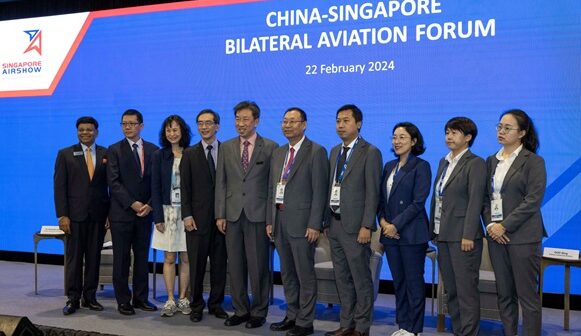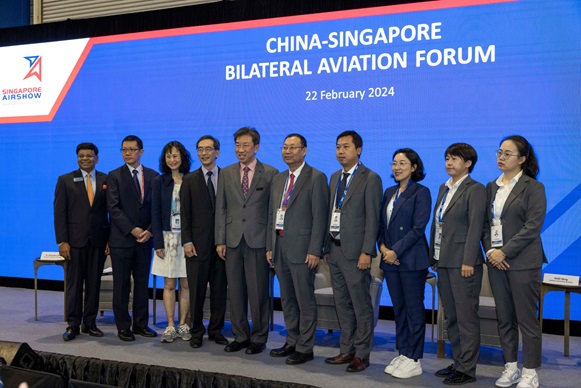
Soaring high above its pandemic hiatus, the biennial Singapore Airshow returned in 2024 (20 Feb – 25 Feb), bursting with renewed energy and ambition.
Emerging from challenges, the aviation industry took off with optimism and aspirations for a promising future, evident in the record-breaking number of nearly 60,000 trade attendees, a 10% increase from the previous high in 2018.
Over 1,000 companies, from industry giants to startups unveiled their latest innovations, from electric vertical take-off and landing vehicles (eVTOLs) to cutting-edge air traffic management systems. 16 country pavilions made their presence, including newcomers from China, Czech Republic, and Korea. The event’s signature flying displays reached new heights with an unprecedented five teams: The Royal Australian Air Force’s Roulettes, Indian Air Force’s Sarang, Indonesian Air Force’s Jupiter, Republic of Korea Air Force’s Black Eagles, and United States Air Force’s B-52 Stratofortress.
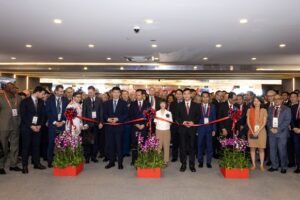
Guests-of Honour Minister for Transport and Second Minister for Finance, Mr Chee Hong Tat, and Senior Minister of State for Defence, Mr Heng Chee How, at the official ribbon cutting ceremony of Singapore Airshow 2024, held at the Changi Exhibition Centre. Photo Credit: Singapore Airshow 2024
Beyond the dazzling exhibits and displays, industry forum discussions tackled talent development, financing, long-haul and regional market recovery, and mitigating external risks. Here are some takeaways on sustainability, advanced air mobility, and China’s rising influence in the industry.
Sustainability Takes Off
As the aviation industry sets its sights on a greener future, aiming for net-zero emissions by 2050, the Singapore Airshow took the lead with a variety of eco-friendly initiatives – from carbon offset programs to a venue powered by 15,000 solar panels.
Stepping further, a dedicated “Sustainable networking zone” built from recycled materials fostered green connections. Delegates arrived at the opening ceremony in style aboard Hyundai’s IONIC 5, Singapore’s first electric car. The sustainability commitment continued in the skies, with the Airbus A350 display flying on a 35% blend of sustainable aviation fuel (SAF).
Singapore Airshow also hosted a “Sustainable Aviation Forum” with expert panels, tackling challenges and opportunities for achieving net-zero aviation emissions.
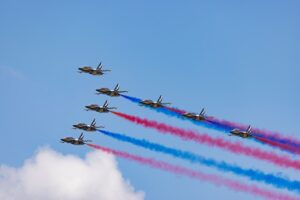
Flying displays – Republic of Korea Air Force’s Black Eagles. Photo credit: Singapore Airshow 2024
Discussions encompassed industry-wide collaboration, financial considerations in adopting SAF, and pathways involving advanced technology and operational efficiency improvements.
In one session, Han Kok Juan, Director-General of the Civil Aviation Authority of Singapore (CAAS) underscored Singapore’s crucial role in the transition towards sustainable aviation.
To facilitate this transition, passengers will contribute a levy ranging from $3 to $16. The national target for sustainable jet usage at Changi and Seletar airports is set to increase from 1% by 2026 to 3-5% by 2030.
Importantly, Singapore isn’t going solo. CAAS is actively partnering with energy, finance, and airline players for diverse suppliers and cost-effective strategies.
Advanced Air mobility (AAM)
Anticipating a USD 17 billion US passenger eVTOL market by 2040[1], the enthusiasm for Advanced Air Mobility (AAM) remains strong, with industry leaders gathering at the AAM Industry Executive Forum to discuss its future.
Panellists noted Urban Air Mobility’s (UAM) untapped market potential: faster intra-city travel than trains, traffic congestion relief, and quieter electric operation. However, challenges were readily acknowledged.
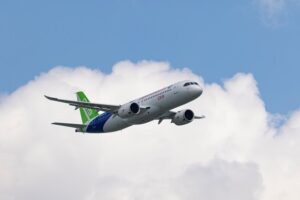
Developed by COMAC, the C919 narrow-body airliner took to the skies in a graceful display for the first time ever at Singapore Airshow 2024. Its presence at the show marks China’s commitment to develop a homegrown aircraft programme, a timely move as global travel demand is on the rise. Photo credit: Singapore Airshow 2024.
Safety stands paramount. Stringent regulations are essential to protect passengers and communities, as Andrew Macmillan (Vertical Aerospace) aptly stated: “we’re flying these with people on them, over people’s houses and into urban areas.” Collaboration with regulators, emphasized by Nikhil Boyle (Archer Aviation), is crucial for navigating the certification challenge.
Accessibility is another hurdle. Diana Siegel (Electra.aero) stressed the need to “bring that price tag down to something where it’s at least usable for everybody.” Addressing noise and safety concerns is also paramount for gaining public acceptance.
China Ascends
The arrival of China’s C919, a homegrown narrow-body jet by COMAC[2], marked a seismic shift in the Asian aviation landscape, potentially challenging the Boeing-Airbus duopoly. This historic moment has Singapore eyeing a strategic partnership to ride the wave.
The aircraft’s international debut at Singapore Airshow 2024 sparked intense discussions about collaboration.
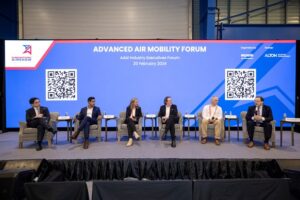
Left to right – Joshua NG (Moderator), Director, Alton Aviation Consultancy; Nikhil GOEL, Chief Commercial Officer, Archer Aviation Inc; Diana SIEGEL, Chief Financial Officer, Electra.aero, Inc.; Johann BORDAIS, Chief Executive Officer, Eve Air Mobility; Arnaud COVILLE, Chief Development Officer, SkyDrive Inc.; Andrew MACMILLAN, Chief Commercial & Strategy Officer, Vertical Aerospace. Photo credit: Singapore Airshow 2024
At the inaugural China-Singapore Bilateral Aviation Forum, industry leaders highlighted the significance of reliability and supply networks. Desmond Goh (Eaton’s Aerospace Group) saw an opportunity: Singapore as a potential C919 MRO hub for Southeast Asia. Philip Sung (Auxitrol Weston Singapore) proposed joint ventures on new technologies and talents, leveraging the strengths of both nations.
Beyond Singapore’s potential role as an MRO hub, the forum fostered a broader dialogue as Chinese cities, including Langfang and Taicang, showcased their aviation ambitions, seeking partnerships and investment from Singapore companies.
Beyond the hype
Singapore Airshow 2024 unveiled a future of flight: cleaner, faster, accessible for all, connecting sustainability with innovation.
Above the clouds, AI’s transformative power, exemplified by “co-pilots” like ST Engineering’s DeepBrain tackling data overload and transforming industries, holds promise to revolutionize aviation with optimized flights, personalized experiences, and enhanced security and maintenance.
Soaring above mere industry excitement, the Singapore Airshow provided a sneak peek into the future, where innovation paves the way for cleaner skies, faster travel, and a more inclusive air travel experience for all.
– – – – – – – – – – – – – – – – –
[1] Welcome address by Mr Ravinder Singh, Chairman, Experia, Singapore Airshow 2024 Opening ceremony, Marina Bay Sands, 19 February 2024
[2] Commercial Aircraft Corporation of China, Ltd. (COMAC)


